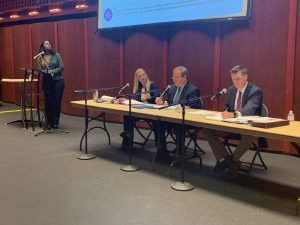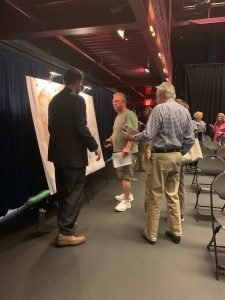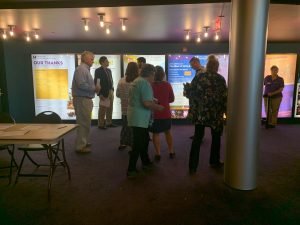 At the table Prince William Planning Department's Rebecca Horner, David McGettigan and Steve Donahoe.
At the table Prince William Planning Department's Rebecca Horner, David McGettigan and Steve Donahoe.Prince William County Planning Staff offered various recommendations for preserving open space in the Rural Crescent, at a public meeting Tuesday. These recommendations would afford landowners greater property rights and allow for more development within the county including in the Rural Crescent.
Should these recommendations be adopted by the board, landowners would have more choices on how to profit on their property, and land would also be preserved allowing for a scenic view-shed, fewer infrastructure needs and the promotion of profitable agricultural businesses and agritourism.
To achieve this, staff proposed revising the county’s comprehensive plan and creating different designations within the Rural Area, thus affording different land-use rules in different zone based upon the character and preferred use of the land. Zones were created without looking at individual property owners.
Guiding principles include preservation of wooded and open land for nature appreciation and passive recreation, preservation for continued farming, bucolic view-sheds, smart growth, preservation of cultural resources, protecting the rural economy and fiscal responsibility.
There will be a public hearing Oct. 16, 2019, on these recommendations before the Prince William County Planning Commission.
 The meeting paused so that people could look at maps and the planning staff could provide further information.
The meeting paused so that people could look at maps and the planning staff could provide further information.Background
The Rural Crescent is located on the southern edges of the county (Brentsville, Coles and Gainesville District) by which the land designation is A1 Agricultural. It was designated in 1998 to limit rapid development in the county.
Today, there are few profitable farms, but people still appreciate the Rural Crescent and would like to halt overdevelopment in the area. At the same time, farmers would like to be afforded more development rights. To develop the Rural Crescent to suburban levels would mean a substantial investment in infrastructure and schools.
Staff plans for Rural Crescent are based upon recommendations made by a consultant in 2014, but also from the input they received from residents. Previous proposals were delayed due to a new Virginia policy towards proffers. This is the third planning meeting this year to discuss evolving proposals.
Planning Director Rebecca Horner noted that at the last meeting in July, residents were split on whether to keep the current Rural Crescent policies or institute new ones.
She clarified that keeping to current policy is not the same as keeping the Rural Crescent as it is today. According to the current A1 Agricultural designation, landowners can divide and sell their land into 10-acre lots. Many are currently doing so, resulting in less open space.
While the majority of emails signify the majority residents would like to keep the status quo, her department believes other options could do more to preserve the land and character of the area.
Rural Transition Ribbon
Prince William Planning Staff has eliminated the “Rural Transition Ribbon” from its recommendations. The Rural Transition Ribbon would have allowed slightly higher density development along the edges of Prince William’s rural area. It would have included sewer hookup.
Planning staff said they eliminated the plan because it received widespread criticism. However, they proposed other plans that are similar.
Conservation Residential
Staff recommends adding a new land-use designation to the Rural Crescent “Conservation Residential” or CR1. This would be a clustered area on sewer, but would protect the entire area from utilizing sewer “by-right.” Homes would be single families 0.5-3 acres surrounded by open space.
Large property owners within the CR1 area could sell to developers to cluster homes as long as 60% of the area is preserved.
TDRs
Staff also recommended the option of transfer of development rights. A TDR means large property owners (20 acres or greater) could sell their development rights. As a result, no new development would be able to be made on that property and property open land would be preserved.
The landowner could keep that property or sell it, but a land preservation covenant would be noted in the deed for perpetuity.
The developer can then take those development rights and apply them in designated areas of the county or possibly another county. Staff designated areas within the Rural Crescent and outside the Rural Crescent to receive these development rights.
Development rights would be determined by new land-use designations.
TDRRs in Rural Area
Where development rights would be received within the Rural Crescent, homes would not need to be on 10-acre lots. They would go within the CR designation on smaller acreage.
TDRRs Mixed Use Residential, High Density
Another place TDR’s could go is within a mixed-use development in the development area. This means building apartments close to retail and transportation. Staff identified four proposed locations in Gainesville, Manassas at Innovation Park and two in Woodbridge.
One location would be Virginia Gateway in Gainesville. Based on data, staff predict it would generate fewer children (hence students) than single families or townhomes. Soon the county could bring in more transit options where infrastructure already exists Other proposed areas are similar in design.
TDR Receiving Areas
PDRs
Purchase of Development Rights is a limited option because it would require the county purchasing the land rights in order to place land into conservation/preservation easements. Grants are available. It is an advantageous tool in preserving open space especially if a specific piece of land was key for view-shed or other reasons.
Arts & Agritourism
The planning department recommends the county find ways to encourage and promote agritourism such as breweries, wineries, farmers markets, farm-to-table restaurants, pumpkin patches with entertainment. These are very popular and it is a way to keep the area rural and bring in economic opportunity.
A “working farms” in the county are only bringing in a small amount of money, something between 1,000 and 2,000 per year. Horner suggested loosening restrictions on home businesses in the area. People could use their homes as art studios, yoga studios, etc. within this area.
“Gateway Corridors”
The county would like to use the edge of the Rural Crescent as a way to promote their agricultural area. It would include signage and land designation would see that land use is attractive.
The county would like to have some open land that is accessible to the public for biking and hiking, but not a park that would generate a large amount of road traffic.
They also believe in preserving historic and cultural resources.
 People looked at development maps at the meeting at the Hyton Performing Art Center.
People looked at development maps at the meeting at the Hyton Performing Art Center.Concerns and Criticism for Rural Area
The biggest criticism among landowners was that the county is choosing “winners” and “losers” because some areas are gaining more land-use rights than others.
The proposals still include sewer, which was a red flag for some.
Concerns and Criticisms for Development Area
The Rural Crescent has ample land for schools and new infrastructure whereas the development area is already overcrowded.
In parts of the county, we have seen apartments bringing in more students than predicted. Elementary schools on the eastern end of the county already surpass intended capacity.
Residential Level of Impact
It is predicted that under the current land-use policy the rural area will see 1,906 new homes. Should the county employ both rural and multi-use TDR’s it will bring in 3,605 family units, a difference of +1,699.
Yet, the planning department believes it will only generate 89 more students because apartments near restaurants and retail attract child-free individuals, while large homes attract large families. This would mean a 10% increase in elementary school populations but not in high school populations.
Support Bristow Beat - Donate Today!